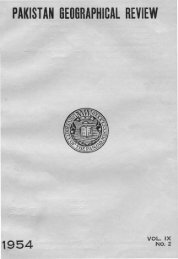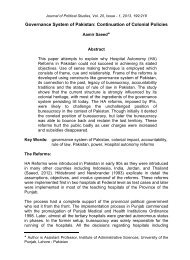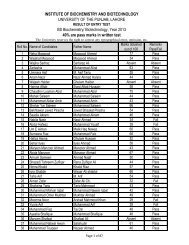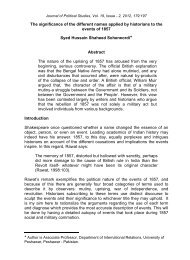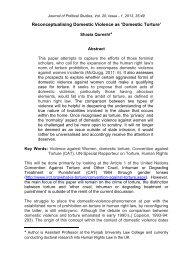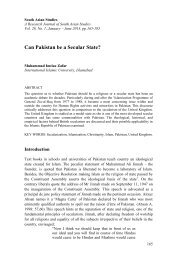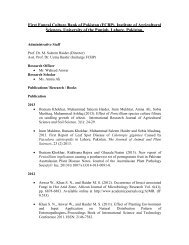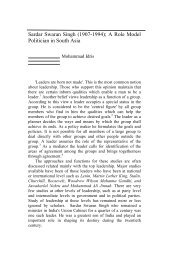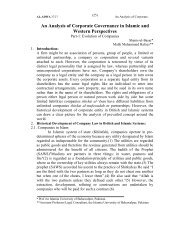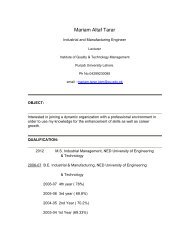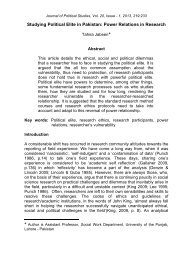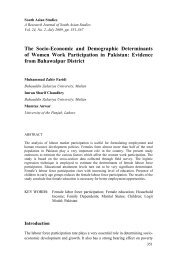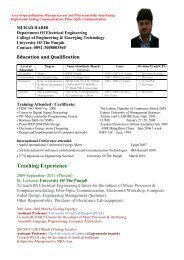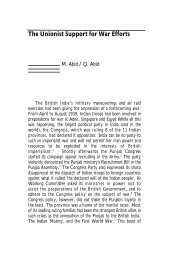Roots of authoritarianism in Pakistan-KU.pdf
Roots of authoritarianism in Pakistan-KU.pdf
Roots of authoritarianism in Pakistan-KU.pdf
Create successful ePaper yourself
Turn your PDF publications into a flip-book with our unique Google optimized e-Paper software.
Journal <strong>of</strong> Political Studies<br />
National Assembly to vote accord<strong>in</strong>g to party l<strong>in</strong>es. He then<br />
bullied the press by arrest<strong>in</strong>g journalists who wrote aga<strong>in</strong>st him<br />
and by order<strong>in</strong>g tax <strong>in</strong>vestigations <strong>in</strong>to those editors who<br />
cont<strong>in</strong>ued to pr<strong>in</strong>t critical articles. He also tackled the judiciary.<br />
When the Supreme Court tried to hear a case <strong>in</strong> which he was a<br />
defendant, Sharif’s supporters ransacked the build<strong>in</strong>g and<br />
terrified the judges <strong>in</strong>to back<strong>in</strong>g down. He moved on to tackle the<br />
presidency and forced Farooq Leghari to resign. By 1998 the<br />
only significant power centre that rema<strong>in</strong>ed untouched was the<br />
army. And when chief <strong>of</strong> army staff, General Jehangir Karamat,<br />
voiced concern about the government’s performance, he was<br />
also forced to step down. But <strong>in</strong> confront<strong>in</strong>g the army, Sharif had<br />
gone a step too far and eventually Karamat’s successor, General<br />
Pervez Musharraf, responded <strong>in</strong> the traditional manner. He<br />
forced Sharif out <strong>of</strong> <strong>of</strong>fice at gunpo<strong>in</strong>t.” 34<br />
The military kept gett<strong>in</strong>g stronger, especially economically, even<br />
dur<strong>in</strong>g the civilian rule(s). “The twice-elected regimes <strong>of</strong> Benazir<br />
Bhutto (1988-90, 1993-96) and Nawaz Sharif (1990-3, 1997-9)<br />
tried to appease the army generals through provid<strong>in</strong>g greater<br />
economic opportunities.” 35 While all other state <strong>in</strong>stitutions<br />
suffered, the military prospered. “The military is the country’s<br />
most powerful <strong>in</strong>stitution. It is the largest organised force with<br />
approximately 700,000 personnel. Compared with this, there<br />
seems to be no s<strong>in</strong>gle democratic <strong>in</strong>stitution <strong>in</strong> <strong>Pakistan</strong> that can<br />
claim to have this number <strong>of</strong> members. In any case, the state’s<br />
democratic system and <strong>in</strong>stitutions are weak.” 36<br />
34 Jones, Owen Bennett, <strong>Pakistan</strong>: Eye <strong>of</strong> the Storm, (New Haven: Yale<br />
University Press), pp. 243-44.<br />
35 Siddiqa, Ayesha, Military Inc. Inside <strong>Pakistan</strong>’s Military Economy,<br />
(Oxford: Oxford University Press 2007), p. 151.<br />
36 Siddiqa-Agha, Ayesha, <strong>Pakistan</strong>’s Arms Procurement and Military<br />
Buildup, 1979-99 In Search <strong>of</strong> a Policy. (London: Palgrave Press,<br />
2000), p. 56.<br />
16



